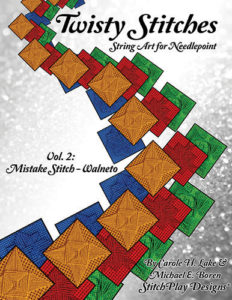
Stitchplay (Carole Lake and Michael Boren), 2016, ISBN: 978-0-9971066-1-9, distributed by Rainbow Gallery, $55.
This volume of Twisty Stitches covers the stitches from Mistake Stitch to Walneto, 7 stitches in all. But what a wonderful collection they are. While both volumes have concentrated on stitches that are related to string art, this volume includes stitches that are more widely used than the “Hilton Stitches” that predominated in the first volume (read my review of it).
Here you’ll find detailed instructions for making Rhodes Stitch (see my all-Rhodes free pattern here), Sprat’s Head, Sheaf Stitch, and one of my favorites, Waffle. All stitches you often find in books but stitches that, like the Hilton Stitches, tend to confuse stitches.
Each of the chapters includes the same information. They begin with a single page text introduction. This page includes background information, general working notes, and tips. Next comes the heart of the book. The basic stitch has a numbered diagram and then a series of pictures that shows you, stitch by stitch, every step until the stitch is complete. This is followed by a picture of both the finished stitch and the backside. If it’s a stitch where the placement of the needle is important, that shown in these pictures as well. There are as many or as few as are needed to complete the stitch, 35 in the case of Walneto.
After the step-by-step pictures there are diagrams and pictures of variations of the stitch. This is where the book shows its immense value for any stitcher. You’ll find 18 different Rhodes Stitches, including two hearts20 Sheaf Stitches, and 14 Waffle Stitches. Because many of these variations can be made in different sizes, you’ve got guides to dozens more ideas.
For me just having so many Rhodes variations in one place is a huge value.
But Lake and Boren don’t neglect the importance of their book to teach needlepoint. That’s so important because so many of us learn primarily from books. All the samples are stitched on white canvas using only one thread, Elegance. The fact that this thread can be thin on 18-mesh means that the stitches can clearly be seen. Each chapter uses only one color of thread, so it’s easy to tell how the variations are different.
My only complaint is that the green used for Sheaf Stitch is a bit dark for details to show clearly, I wish a different color had been used.
That’s a very tiny flaw in a book that is so good it should be on every stitcher’s bookshelf.
About Janet M Perry
Janet Perry is the Internet's leading authority on needlepoint. She designs, teaches and writes, getting raves from her fans for her innovative techniques, extensive knowledge and generous teaching style. A leading writer of stitch guides, she blogs here and lives on an island in the northeast corner of the SF Bay with her family

Leave a Reply